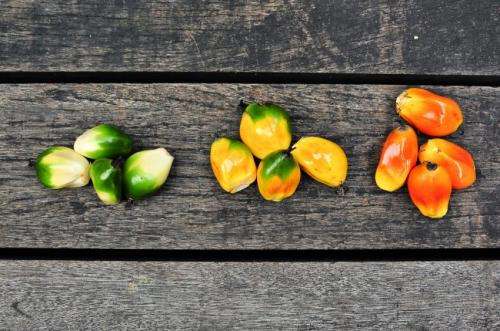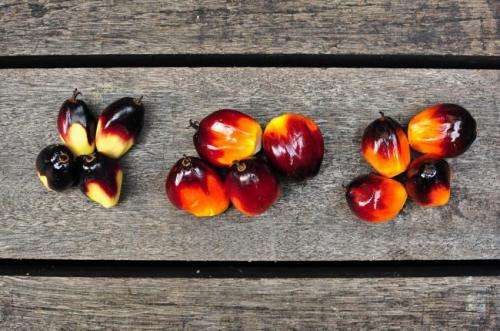Newly identified gene provides reliable visual cue for oil palm fruit ripeness

A genetic discovery by a team of scientists from the Malaysian Palm Oil Board (MPOB), aided by scientists from Orion Genomics, paves the way for increased production of palm oil, which accounts for 45 percent of the world's edible oil, while also helping to conserve sensitive wild habitats at risk of being turned into agricultural land.
In the study published in the journal Nature Communications, the scientists identified the VIR gene as responsible for fruit color. Currently, the majority of the oil palm fruit harvested in Malaysia and Indonesia is the nigrescens variety of fruit, which has black to deep purple skin that changes little when ripe. However, in the rare virescens oil palm, fruits change color from green to bright orange when ripe, signaling the optimal time for harvesting. Palm oil is used in a plethora of consumer products, from lipstick and toothpaste to cooking oil and countless grocery items.
Every day, across 15 million hectares of Indonesian and Malaysian palm plantations, harvesters spend their days gazing up at the fruit, which can be up to 60 feet above them, trying to determine if the purple orbs are at their peak ripeness and oil content. Often they look for fruit on the ground to indicate a mature bunch overhead. Still, it's a judgment call for harvesters to decide which bunch in which tree has dropped fruit and is therefore ready for harvest. Harvest fruit too early, and oil yields are significantly decreased. Overripe fruits yield lower quality oil as well.
Now equipped with the VIR gene knowledge, palm growers can begin to replace their nigrescens palms with virescens plants, which will eventually eliminate the need for harvesters to make a judgment call on over 20 billion bunches of oil palm fruit harvested annually. This will increase the efficiency of the harvest and the oil yield from existing agricultural lands.

Even a 1 percent increase in Malaysian palm oil yield alone is worth in excess of RM 1 billion (USD 330 million) annually.
Five naturally occurring mutations in the VIR gene conferring the desirable trait were documented in different populations of oil palm that were collected in Africa by Malaysian-government sponsored scientists during the last 40 years, long before the widespread adoption of genetic sequencing.
"For more than four decades, Malaysian scientists have been collecting wild specimens of oil palm from across the globe, and without these materials, it is unlikely that we would have identified the VIR gene," said Raviga Sambanthamurthi, PhD., Director of MPOB's Advanced Biotechnology and Breeding Centre and lead author of the paper. "This collection, along with the recently completed genome sequence, is accelerating discoveries in oil palm genetics and epigenetics, and paving the way to increased productivity."
This identification of the VIR gene complements the same scientific team's earlier discovery of SHELL, a gene that studies published in Nature last year show leads to a palm fruit with oil yield up to 30 percent superior. By combining the VIR and SHELL gene traits, breeders can develop palm lines that will further boost the efficiency of harvest and profoundly impact oil yield.
With the world's population expected to grow to 8 billion people within the next 15 years, there is mounting pressure for agricultural lands to meet increasing demands for food worldwide. The MPOB team's discoveries go to great lengths to ease that pressure in the regions where a large percentage of the world's oil palm is grown and where there's pressure to preserve wild species' habitats rather than clear it for agricultural land.
"Feeding the world's growing population may be possible through the application of technologies to boost crop yields on existing agricultural lands," said Robert A. Martienssen, Ph.D., co-author of the study, scientific co-founder of Orion Genomics, who is also a Howard Hughes Medical Institute Investigator and Gordon and Betty Moore Foundation Investigator and Professor of plant genetics at Cold Spring Harbor Laboratory in New York. "And the identification of VIR and SHELL are just early steps. With the oil palm genome sequence in hand, thanks to decades of work by MPOB scientists, there is now tremendous potential to identify additional genes that increase yield for years to come."
More information: "The oil palm VIRESCENS gene controls fruit colour and encodes a R2R3-MYB," Nature Communications DOI: 10.1038/ncomms5106
Journal information: Nature Communications
Provided by Malaysian Palm Oil Board
















